The first thing you’ll probably do when planning your trip to Iguazu Falls is try to decide which side of Iguazu Falls is better.
But ideally, you should visit both.
Since the falls actually are on Argentina’s side of the border, from Brazil’s park you get a spectacular panoramic view of the falls.
If Iguazu Falls were an orchestra, in Argentina you’re on the stage and in Brazil you have a front row seat.
By going to both country’s parks you experience it all, from afar and from within.
This post will leave you completely prepared for a visit to the Brazil side of Iguazu Falls.
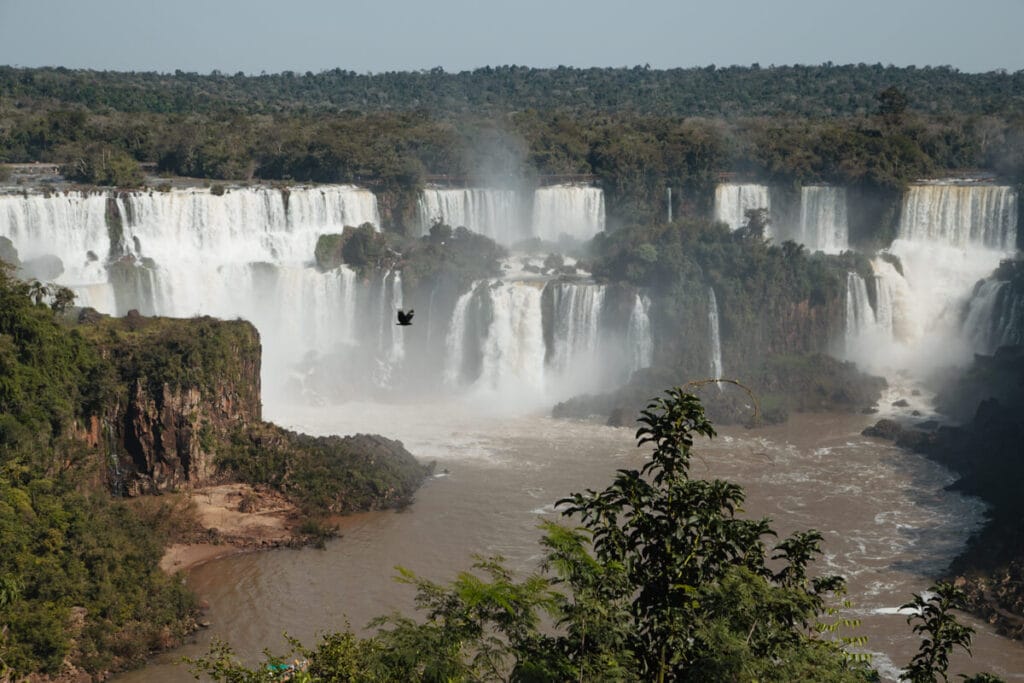
QUICK NOTE: This post contains affiliate links and Sol Salute may receive a commission for purchases made through these links, at no extra cost to you.
NOTE ON TOUR OPERATORS: I link to tours on three tour aggregators – GetYourGuide, Viator, and Tangol. All are reputable. I do my best to find the most affordable option of the three but prices and availability can vary.
Visiting Iguazú Falls Brazil: The Important Details
- Parque Cataratas do Iguaçu is open every day from 9 am – 4 pm.
- TIP: They list the best hours to visit for fewer crowds as 9-9:30 am and from 2-4 pm.
- COST: For foreigners it costs 100 reais (around $18 US), Brazil/Mercosur citizens cost 91 reais (around $16.50), and it’s free for children under 6
- In Person or Online: You can purchase tickets in person or online here. If you want the first entrance slot or go during busy season, buying online helps avoid queues. In low season, it is less important (we went in August at 11:30 am and there were no lines).
- VIP PASS: For an additional 49 reais per person ($9) a VIP Pass allows you to jump the queue for the bus that takes you from the entrance to the falls. During low season this isn’t necessary but it’s a gamechanger during peak season. Children under 6 do not need to purchase a VIP Pass if accompanying an adult with one.
- There are restaurants and restrooms located throughout the park.
- LOCKERS – There are large lockers outside the entrance, you can pay for them at the kiosks when you pay for your ticket or online here. They would hold a backpack easily or a small carry on.
- READ NEXT: A Complete Guide to Iguazu Falls, Argentina Side
Iguazu, Brazil Tours
- Brazil Side Day Trip from Puerto Iguazu | Staying in Puerto Iguazu in Argentina? This tour will cover a half day trip to Brazil’s side of the falls, easy peasy.
- Complete Iguazu Falls Brazil Experience | This is a complete day trip of all the big experiences on the Brazilian side – the falls, the boat tour (Macuco Safari), the bird park (Parque das Aves), and the helicopter ride.
- Iguazu in 2 Days | This trip includes flights from Buenos Aires and one night in a 4-star hotel. You’ll see the Brazilian side on day one and the Argentine side of the falls on day 2.
- Iguazu in 3 Days | This trip is similar to the 2 day itinerary except at a slower pace. It includes flights and two nights in a four star hotel. Day one will be spent on the Brazilian side and day 2 in Argentina, on the third day you’ll return to Buenos Aires.
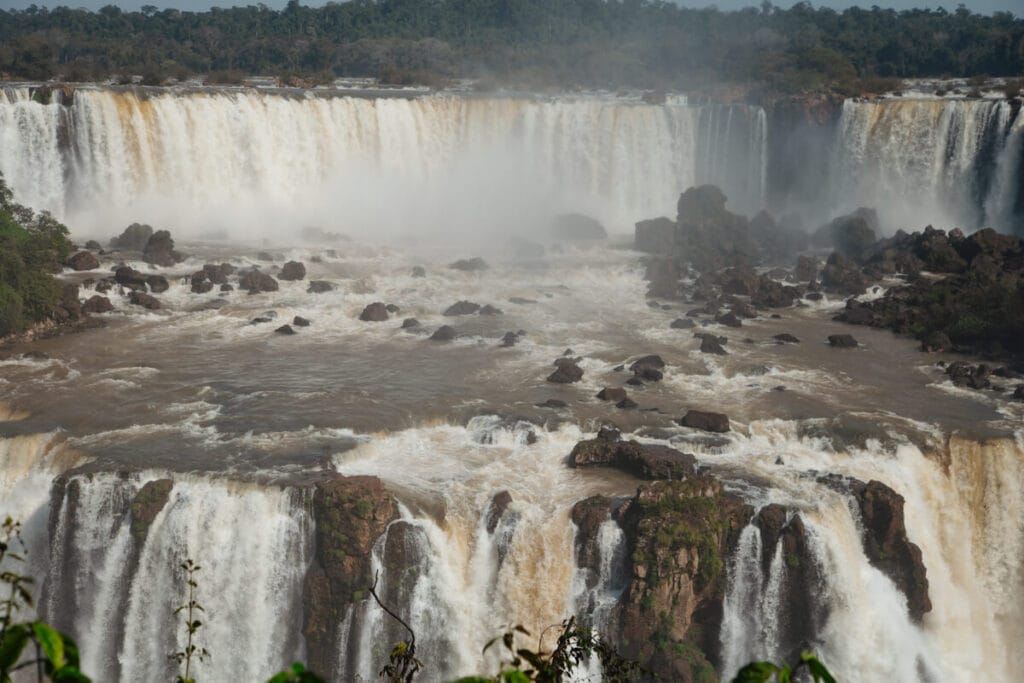
What to Expect in Iguazu falls, Brazil Side
When you arrive to the entrance of the park, you’ll purchase your tickets from the computer kiosks. Here you can also purchase a VIP pass and/or a locker rental.
If you’ve purchased your tickets online in advance – which is a must in peak season or if you’re nervous/on a tight schedule – then you’ll skip the kiosks head to the line to enter with your time slot.
This line is for the bus to the falls from the entrance.
The park entrance is actually quite far from the falls and you’ll take a 15 minute bus ride to the trail entrance.
These time slots are meant to avoid rushes on the bus at arrival. Once in the park you’ll explore on your own (these aren’t tour groups).
You’ll queue up for the next bus back to the entrance when you’re done. You don’t have a specific return.
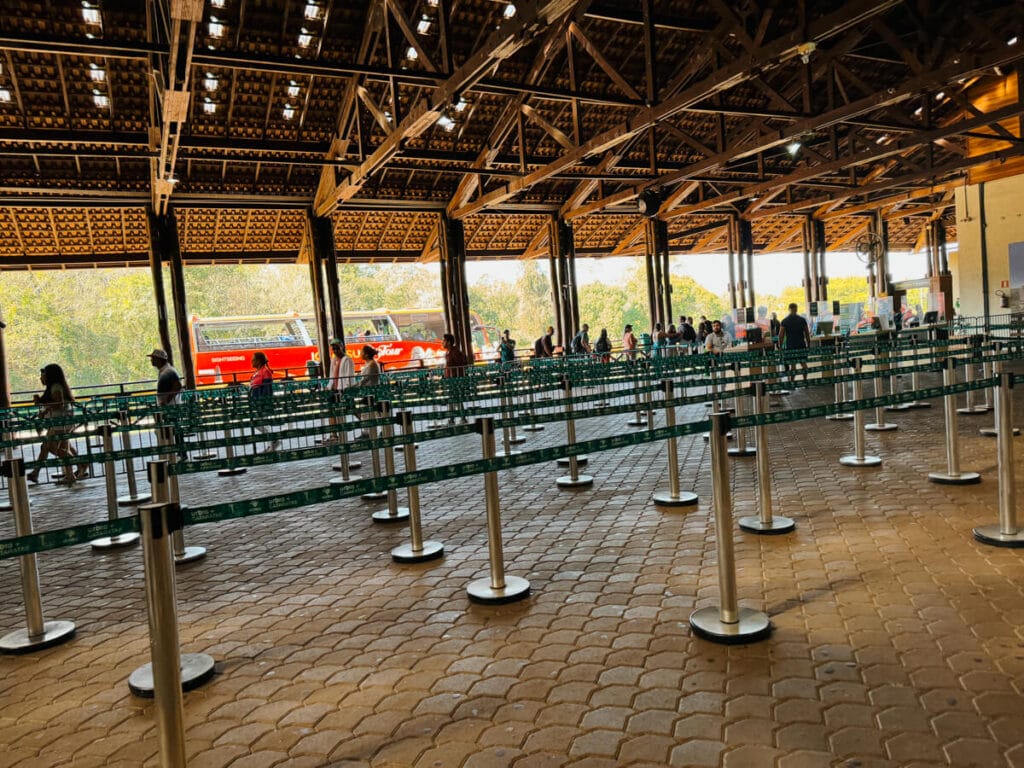
If going during busy season, investing the extra money on a VIP Pass is ideal to jump these lines as you could be waiting upwards of an hour or two.
During low season, you can be more relaxed about buying tickets in advance and skip the VIP Pass. We visited in August and there was never a line for anything.
The bus makes two stops before you reach the falls – at the Poço Preto Trail and the Macuco Safari. Both of these are guided excursions that you must purchase in advance. The bus will only stop for those passengers who have.
At the third and final stop you’ll have reached the falls. Get off the bus and explore!
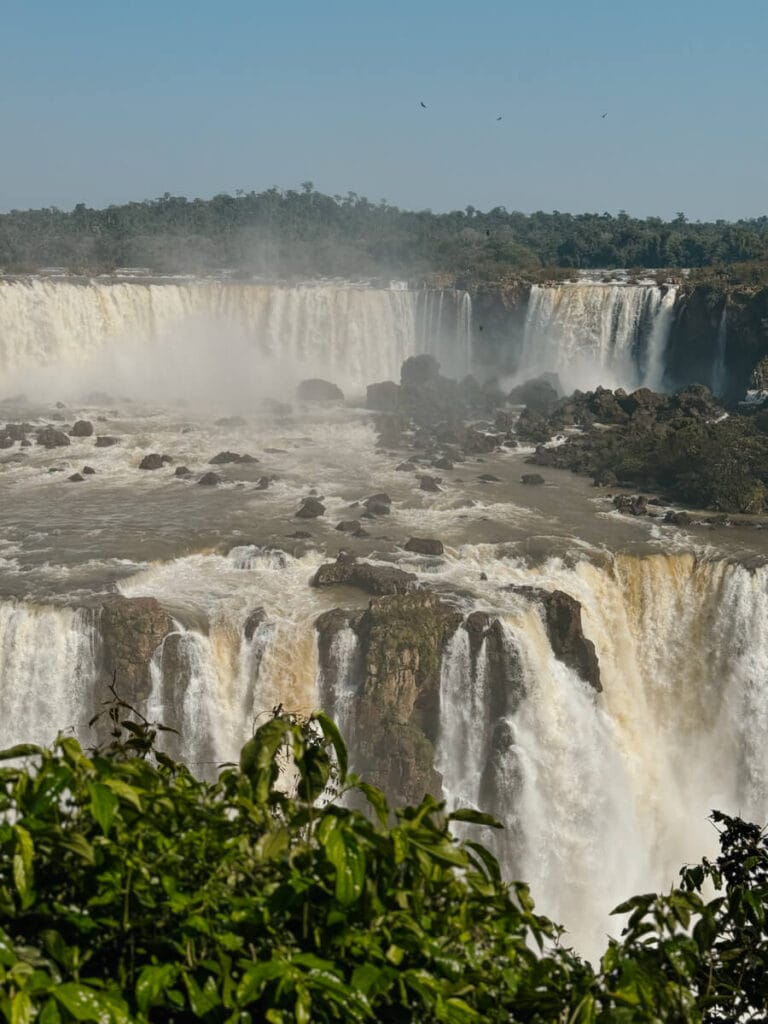
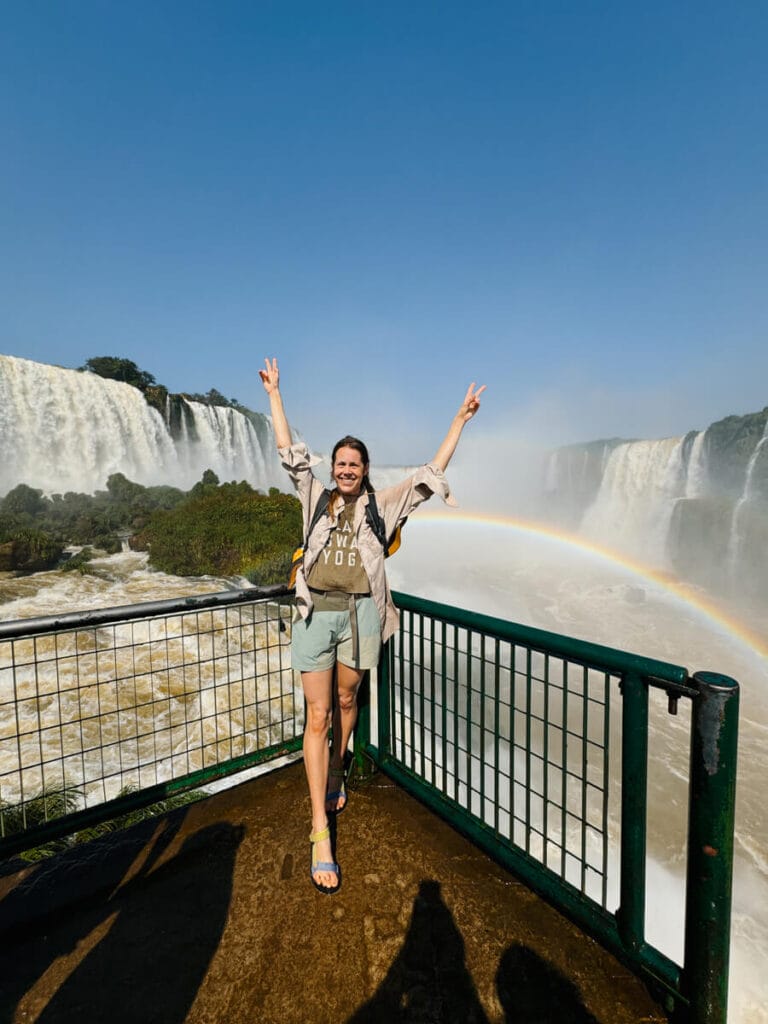
How to See Iguazu Falls in Brazil
Viewing the falls in Brazil’s side of Iguazu is actually very short compared to Argentina’s side.
You can walk the trail in about 90 minutes or less and most people are finished with the entire park in about 2.5-3 hours.
We took four hours from 11:30 until 3:30, but we really took our time at a toddler’s pace with two kids, stopping for a short picnic in the middle and a long break for açaí by the river at the end.
There are a lot of stairs throughout so this is not wheelchair or stroller accessible. Our four year old walked and we brought our Ergo Baby carrier for our two year old. A friend took their Deuter hiking carrier for their older toddler when they went.
The path is a non stop panoramic view of the falls in front of you with a few photo ops placed throughout. At regular intervals there are snack bars and bathrooms.
At the end of the trail you’ll reach the star of the show – the Devil’s Throat. Here there is a metal catwalk that leads out over the river as close to the base of the falls as must be safely possible.
Here you will get soaked but feeling the power of the falls here is so impressive!
If getting wet bothers you, you can pick up a plastic poncho at the gift shops or pack a reusable one like this. We chose just to get wet and dry off in the sun after.
After this, you’ll take the elevator or stairs up to the top of falls. There’s a final photo op here – your own or paid from their official photographers.
From here you’re done and free to leave for your next adventure or you can grab a bite at the restaurants. There is a final snack bar (kiosco) here or you can keep walking away from the falls to the bus stop where there are two restaurants – a fast food style spot and a sit down restaurant.
I was NOT going to be in Brazil and not have açaí so at the fast food spot I ordered exactly that and it was heavenly.
We shared it by the river and it was a beautiful way to end the day.
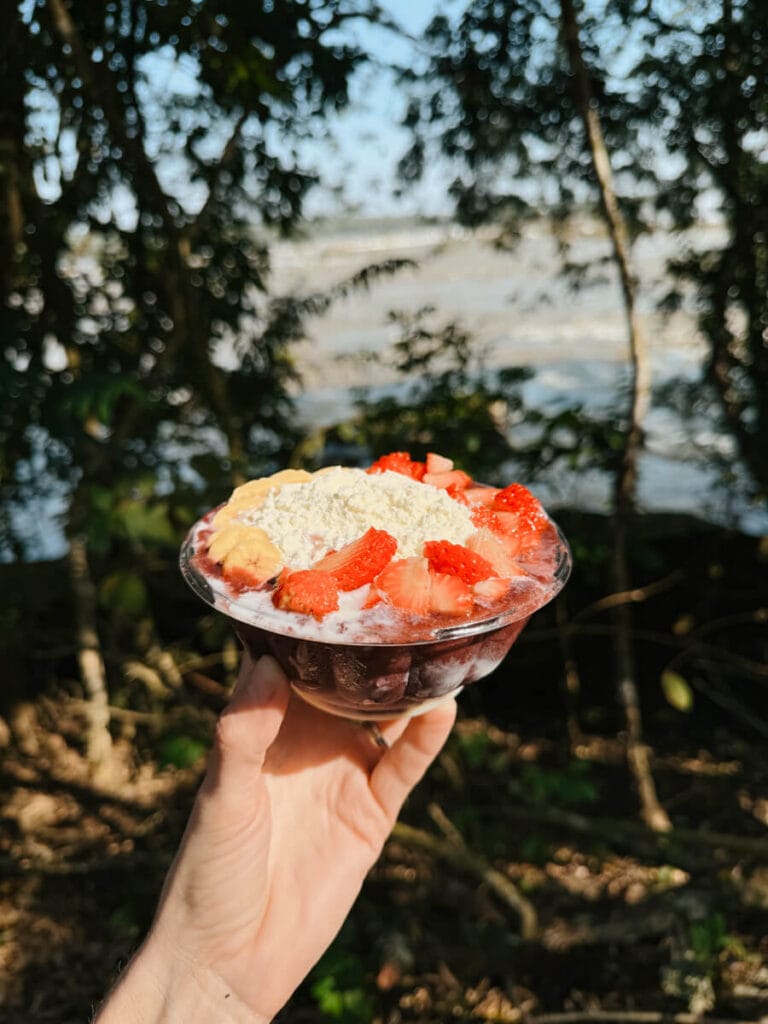
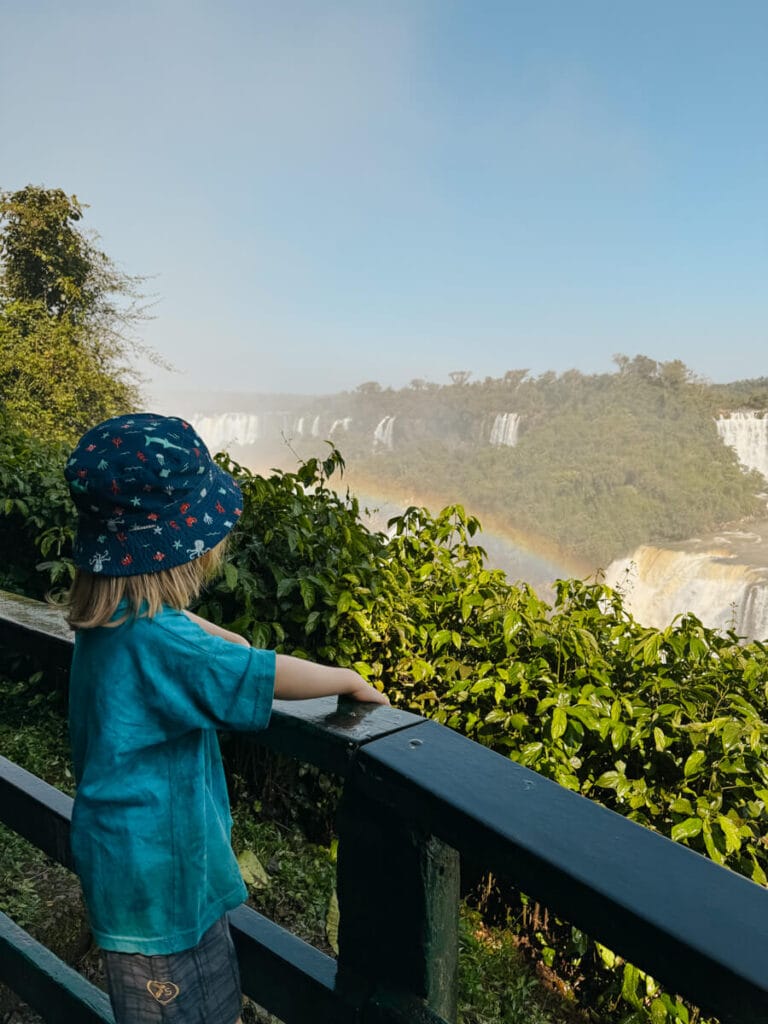
Macuco Safari – The Boat Tour
Going on a boat excursion is one of the absolute must do experiences in Iguazu.
You can do this on Argentina’s side (via Gran Aventura) or here on Brazil’s side (via Macuco Safari).
The experience is the same on either side and they even cost the same (at around $70 US), so you can choose to do the tour on the side that is most convenient for you.
My suggestion though, is to do it here in Brazil.
Argentina’s side of the falls requires a lot more time to see the upper & lower circuits and Devil’s Throat.
If you only have one full day to spend in Argentina, do the boat here in Brazil which requires so much less time.
Traveling with kids? Then definitely do the boat here if it’s important to you. Argentina only allows children 12 and up. Brazil’s Macuco Safari has no age restrictions.
We skipped the boat ride but were told that Macuco Safari offers an option that doesn’t go under the spray of the falls, which is a lot gentler for smaller children.
You can reach out to them via WhatsApp on their website for specifics.

Poço Preto Trail
I love to dedicate a ton of time to a destination that most people fly right through, and the Poço Preto Trail is an option to do just that.
If you’re staying in the park here at the Belmond Hotel das Cataratas or in Foz do Iguaçu and plan on a second day in the park, then a hike or bike ride down this 9 kilometer trail is an excellent way to experience the jungle away from the crowds.
You have to visit with a guide and can book the bike experience on the park’s official website. The hotel in the park also offers guided walks.
Since I have yet to go myself, here’s a blog post I read from a group that stayed at the Belmond and their experience hiking this trail.
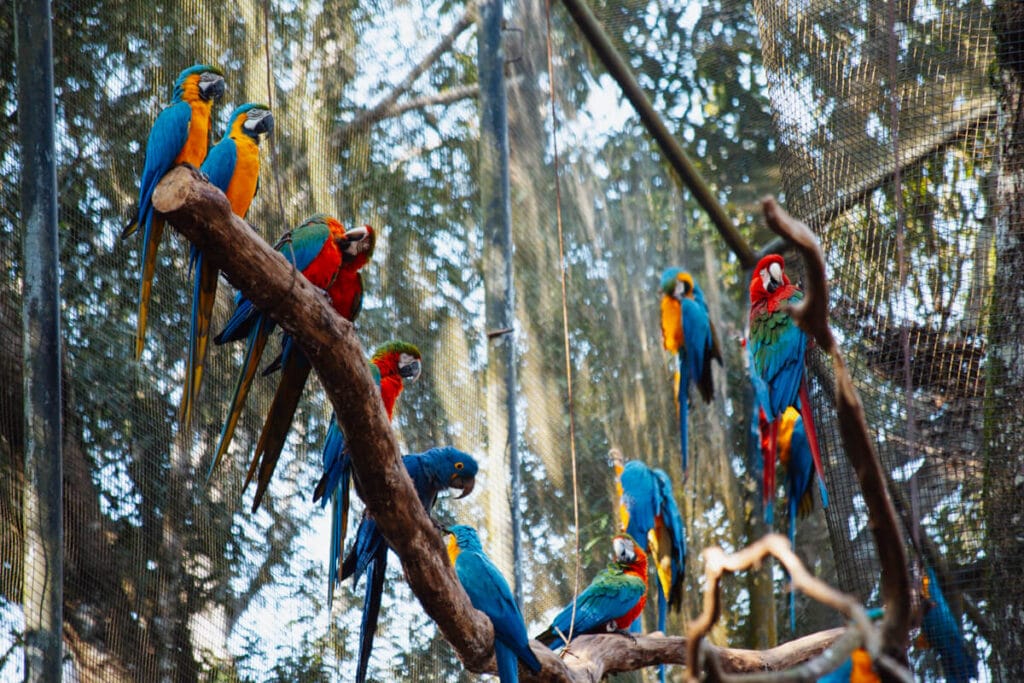
Things to do in Foz do Iguaçu Brazil
Since the Brazil side of Iguazu Falls takes just half a day then you may be looking for other things to do here to fill the day.
The most common activity to add on to your Brazil Iguazu itinerary is the bird park – Parque das Aves. I highly highly recommend it.
This is also the only side where you can do a helicopter ride over the falls.
Here are more details on what to do with the rest of your day if you have the time.
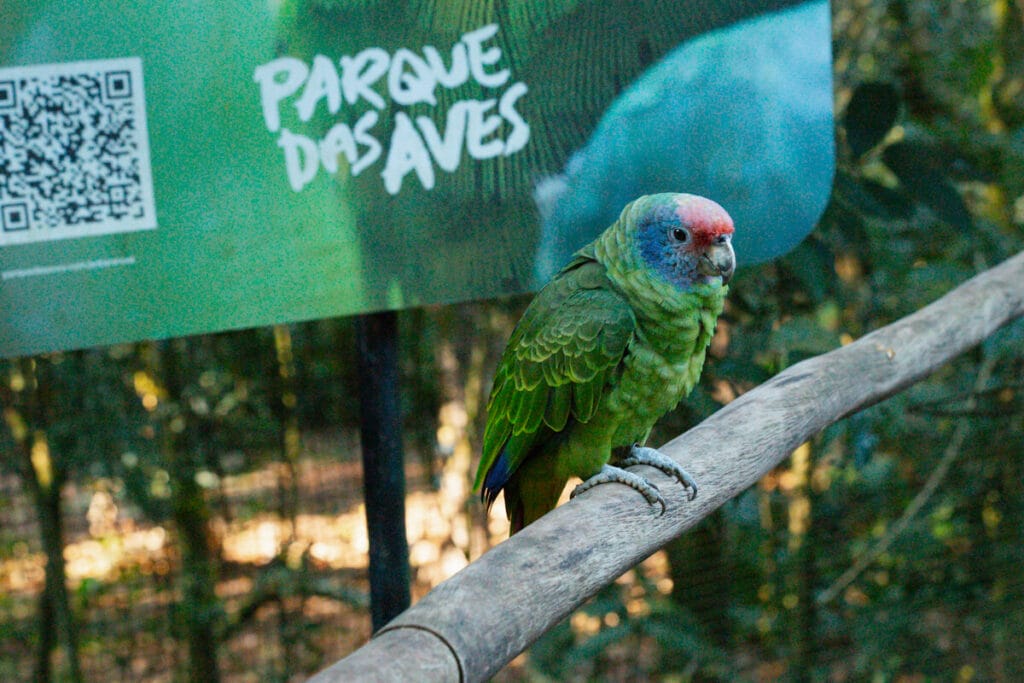
Parque das Aves
The Parque das Aves is the best thing to do in Brazil’s Iguazu before or after the falls.
The trail weaves through 16 hectares of Atlantic Rainforest. There are 1,300 birds and more than 130 different species.
They work for conservation and about half of the birds here have been rescued.
It takes about 90 minutes for a complete visit and the park is open every day from 8:30 am to 4:30 pm.
There is a snack bar and cafe at the front and bathrooms throughout the trail. It is wheelchair and stroller accessible.
Best time to go? They feed the birds in the morning so if you can go then you will see more birds as they are more active then.
We started here at around 9:30 and then went to the falls at 11:30, finishing that park at 3:30, for example.
→ Book this highly rated tour includes a visit to the bird park with the falls or go with a driver that can take you to both.
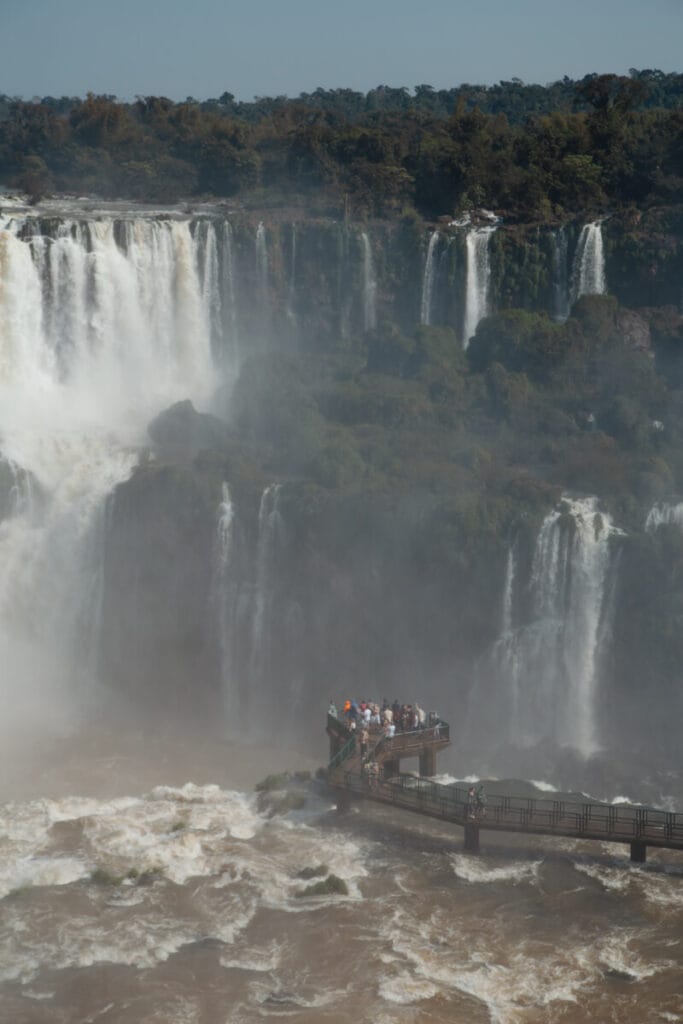
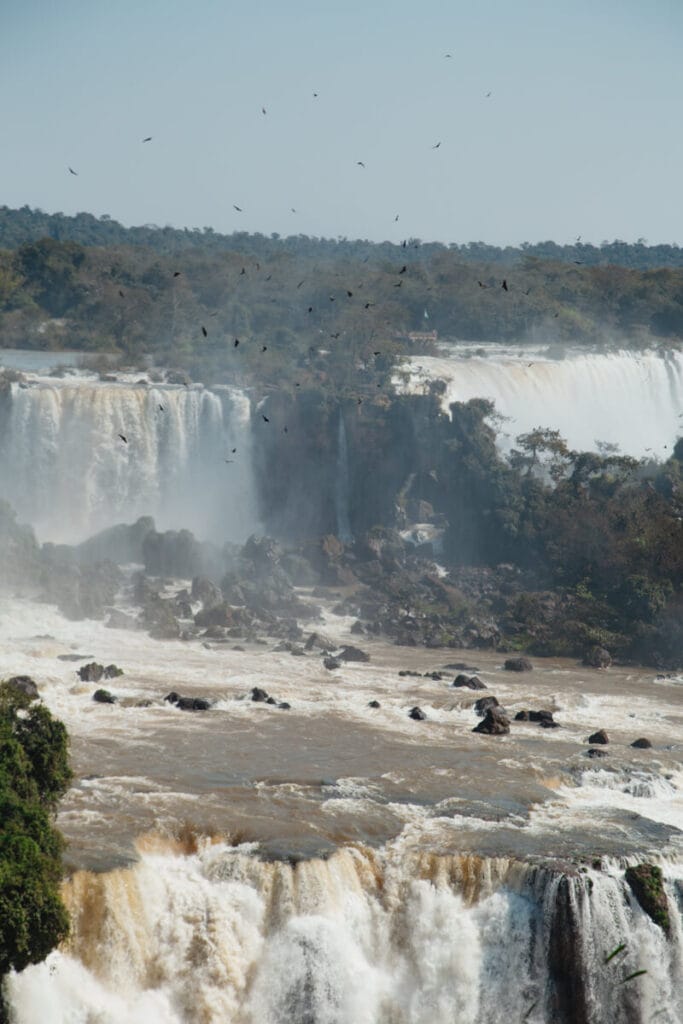
Helicopter over Iguazu Falls
A popular way to see the falls is from above via helicopter.
This is only possible on the Brazil side of Iguazu because Argentina has banned helicopters to protect the wildlife.
We chose not to do this because we agree with the Argentina government on this one. We also found the noise of the helicopters was also really quite intrusive while in the parks.
But if you’d like to do it, it’s a 10 minute ride and the helipad is across the street from the Parque das Aves and the falls entrance in Brazil.
→ You can reserve the helicopter ride alone here or book this complete day trip that includes the falls in Brazil, the Parque das Aves and the helicopter.
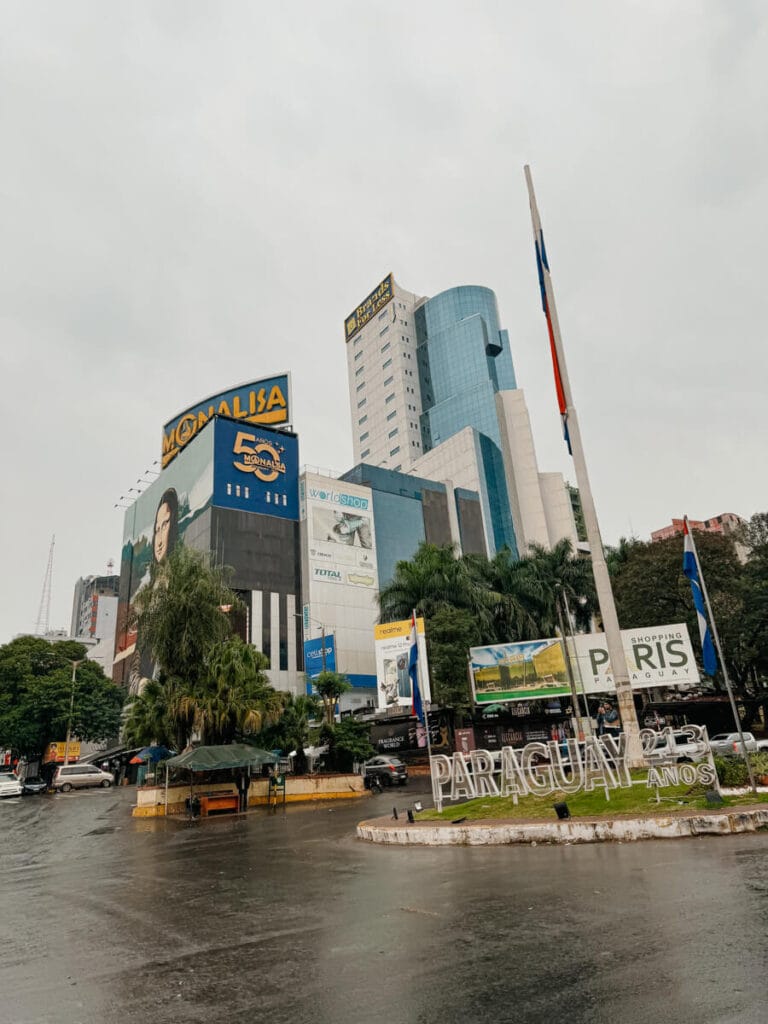
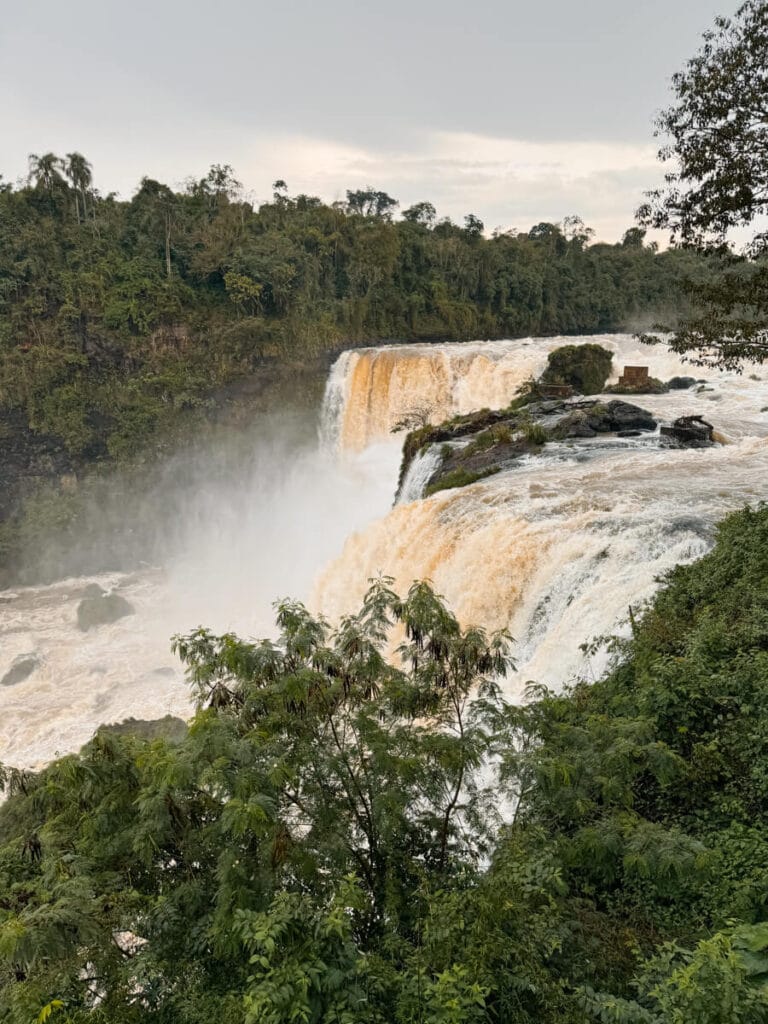
Go to Paraguay
A third option is to leave Brazil entirely and collect another passport stamp – go to Paraguay!
Since Iguazu is a triple border it’s as easy as crossing a bridge to reach your third country in a single holiday (a bridge and immigration, of course).
Ciudad del Este is just on of the other side of the river and is, if we’re honest, not beautiful. But it is a major destination, why? For shopping.
A lot of people cross the border to buy clothes and electronics at much cheaper prices than you’ll find in Argentina or Brazil. If you’re coming from the US, this isn’t really tempting.
An alternative option is to visit Monday Falls, 15 minutes from the border.
If it weren’t for being overshadowed by Iguazu’s grandeur they’d be a destination in their own right. We really enjoyed our afternoon there and the falls are stunning.
→ You can book a tour like this or hire a driver to take care of the entire day. We went with Guillermo de la Rosa from Puerto Iguazu, you can send him a WhatsApp to +5493757673892 to reserve with his team.
FAQ: Iguazu Falls, Brazil Side
Here are some quick answers the most frequently asked questions for visiting Iguazu Falls’ Brazil side.

Where to stay in Iguazu Falls, Brazil
- The Belmond’s Hotel das Cataratas | If you have budget for it, this is the best option, hands down. You’ll be steps from the falls with easy access for unique tours after park hours (sunrise, sunset, and moonlight tours). By having more time here you can visit less visited areas like the Poco Preto trail or just relax the luxurious pool.
- The Doubletree | A great option for families looking for a more budget friendly resort feel with a water park.
- Where to stay in Puerto Iguazu, Argentina | Otherwise, I always recommended basing yourself on Argentina’s side, so read my complete guide for that!
How long do you need to visit Iguazu Falls, Brazil?
Brazil’s side takes significantly less time than Argentina’s side of the falls. You can be done in half a day.
They recommend 90 minutes for walking the trail to see the falls and that felt accurate for our experience.
Of course, you’ll add one about 20-30 minutes each way to get to the falls and back from the entrance, depending on lines.
And if you choose to do the Macuco Safari boat ride here you’ll need to budget in two more hours.
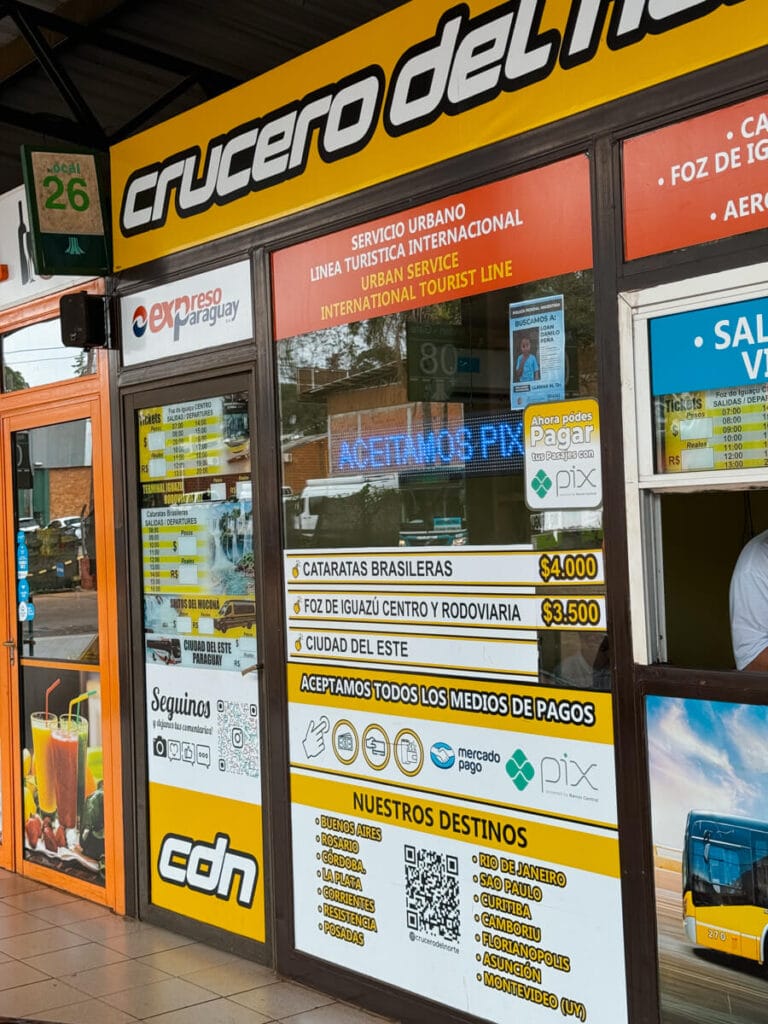
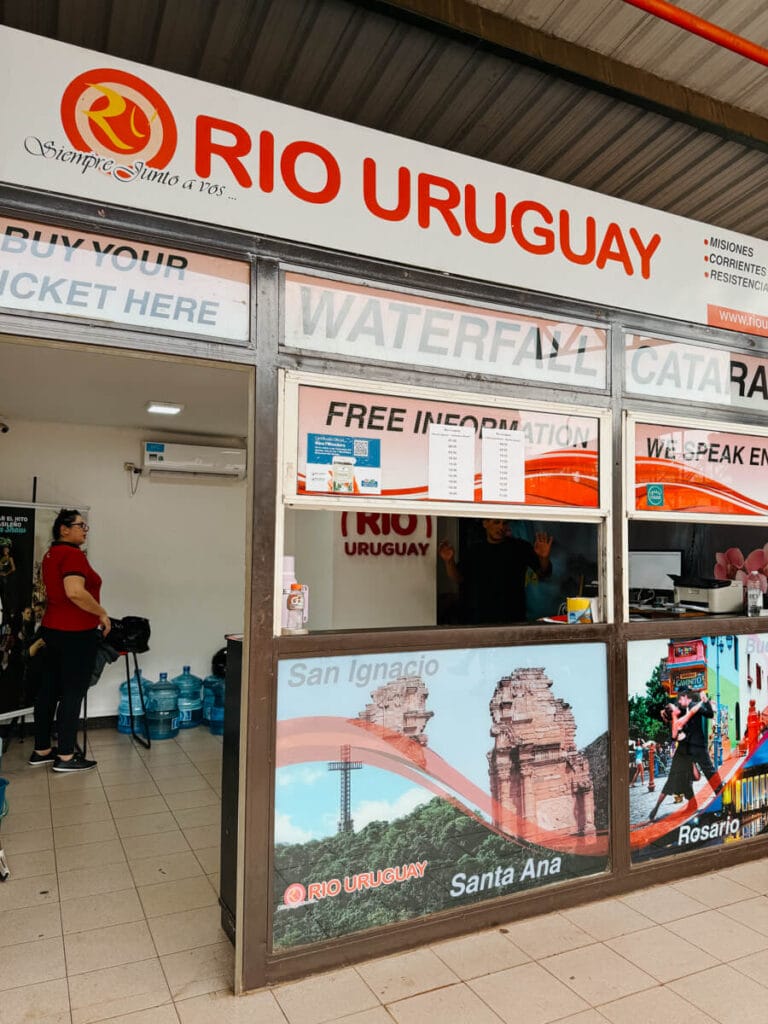
How to get to Iguazu Falls in Brazil
If you’re in Foz do Iguaçu, you can take a bus, taxi, or Uber to get to the falls.
Visiting from Puerto Iguazu in Argentina, you can take one of three options:
- Hire a tour and go with a small group or a private guide – like this tour.
- Hire a driver, we went with Guillermo de la Rosa and his team, you can send him a WhatsApp to +5493757673892.
- Take the bus with Rio Uruguay from the bus terminal in downtown Puerto Iguazu. They leave regularly and as of August 2024 it cost 8,000 pesos each way. They run every hour on the half hour (confirm in person).
- A new bus company, Crucero del Norte, has also started operating this route, undercutting Rio Uruguay’s price to $4,000. They run every hour on the hour (confirm in person).
You’ll have to go through immigration leaving Argentina and entering Brazil (and vice versa on the return).
This is fastest with a driver or tour guide as they have a preferential line. The time saved is golden if you’re there in peak season.
If you take the bus, you will have to get off the bus and walk through immigration. The bus will wait 10-15 minutes but if the line is long or particularly slow, it will leave and you’ll have to wait for the next bus.
What to pack for Iguazu Falls?
You’re going to get wet, it’s inevitable, so bring shoes and clothes that can get wet.
Along with that, sun protection, insect repellent, and of course your camera should be at the top of your Iguazu packing list.
- A day pack: Pack a small backpack for most comfort to walk the trails (versus a shoulder bag).
- Teva Sandals are my favorite because they’ll also give you good grip and traction and are cooler than a sneaker.
- Quick dry clothes: Prioritize comfort with DRI-FIT shirts and quick dry pants (I lived in my hiking shorts).
- Binoculars: Pack a good pair of binoculars to more easily spot the wildlife and toucans that are hiding deep in the jungle. Read my post here listing the best travel binoculars.
- Rain poncho: You might choose to wear a poncho on the viewpoint at the base of the Devil’s Throat, where you WILL get soaked, along with the boat ride. Pack a reusable one like this to avoid waste or pick up a disposable one in the gift shops if needed.
- A water bottle, the jungle days get hot. I like my Hydroflask with a straw lid so I don’t have to take off the lid and risk clumsily dropping it into the falls (I lost a lens cap this way). You can re-fill at water fountains throughout Brazil’s park.
- Protection from the sun: sunscreen, a sun shirt, a hat, & sunglasses.
- This sun hat: I swear, go full on safari, you won’t regret it. I wore a hat just like this and it made the walks in the sun enjoyable, keeping me cool and the chin strap came in handy with the wind at Devil’s Throat.
- Insect repellent: There are a lot of mosquitos at sunrise and sunset (not Dengue carrying mosquitos but the bites do itch). These OFF wipes are ideal, they weigh very little and you’ll avoid trouble with security (don’t travel with aerosol).
- Phone lanyard: Avoid dropping your phone into the falls when taking all your pictures by wearing it as a necklace (tip from a real butter fingers).
- Portable phone charger: You’ll likely be using your phone all day to take photos and video, don’t forget a battery bank to keep your phone charged all day.
- A quick dry towel that you can toss in your backpack or tote to dry off after going on the boat ride (you will get soaked!).
Read More: The Best Things to do in Iguazu Falls Beyond the Falls
When to visit Brazil’s Iguazu Falls
Iguazu is a great destination year round.
That said, there are times to visit that are better and times I’d avoid if your schedule allows.
This is the jungle, so you can expect hot and muggy summers. If going then, be sure to wear sun protection and hydrate.
Winter is ideal for fewer crowds and more agreeable temperatures. It will still be warm but you won’t suffer. We just went in August and it was an idyllic 80 degrees throughout our stay.
Is there a rainy season? No. Iguazu is subtropical so there is no particular rainy season. It can and does rain all year, usually with sporadic storms rather than torrential day long downpours.
When to avoid Iguazu? School holidays. The month of January is the busiest travel month (but summer break is from the holidays through February). The final two weeks of July is the winter school break. These breaks bring massive crowds. If you go then, book your hotels in advance and bring patience.
Argentina Travel Resources
- BOOK A CONSULTATION | I offer one-on-one travel consultations to help you plan your trip to Argentina. Pick my brain to get a local’s insight. Click here for more information.
- MY MAP | Buy my interactive map with 300+ pins to have access to the city as I see it. It is an invaluable resource. See more here about how it works.
- AIRPORT TRANSFERS | Having a driver waiting for you is ideal for a stress free arrival, Welcome Pickups is the best option for a driver from Ezeiza or Aeroparque.
- TRAVEL INSURANCE | Always travel insured. Anything can happen anywhere and it is scarier and costlier in an unfamiliar country. SafetyWing’s Essential Plan covers unexpected travel and medical emergencies and even offers add-ons like electronics theft or adventure sports. It is the best if you’re coming on vacation. If you’re coming as a digital nomad or an extended stay, you need their Complete Nomad Plan which also covers routine check ups, maternity, mental healthcare and more. Read more: Health Insurance in Argentina
- PHONE PLAN | These days, traveling with data is essential. Especially in Argentina where everything is managed on Instagram and WhatsApp. I recommend this E-SIM card. It’s hassle-free and affordable, for more read how to get an Argentina sim card.
- ACCOMMODATION IN ARGENTINA | booking.com is the most common hotel site used in Argentina and it’s where you’ll find the most options.
- RENTAL CARS | I love to travel Argentina via road trip, Discover Cars is a great platform to compare different rates and providers.
- BUS TICKETS | Check Busbud for long distance bus routes and tickets.
- VPN | If you’ll be using a public WiFi connection and want to secure your data, I highly recommend using a VPN, I personally use and have had a good experience with ExpressVPN. I also use it to access Hulu and American Netflix from Argentina.
- FLIGHTS | Always check Google Flights and Skyscanner for flights to and within Argentina. Aerolineas Argentina is the local airline with the most routes. FlyBondi and Jetsmart are two budget airlines with dirt-cheap prices (but expect to pay for every add-on like luggage).




Thank you for sharing your jurney! We just visited the Iguazu Falls in Argentina and took a day trip to Paraguay yesterday, where we also got to see one of the largest dams in the world – Itaipu. We did contact Guillermo for transfers, but he was not very reliable. He ended up outsourcing both transfers to another driver with very little notice. I wouldn’t recommend going with him.
I’m sorry you weren’t happy with Guillermo but at least it sounds like he did arrange transfers for you. He manages a team of drivers he has vetted to reach his standards of service, so I hope you had a lovely experience with your assigned driver regardless.